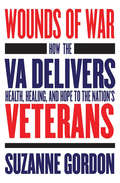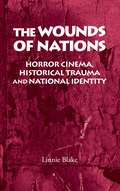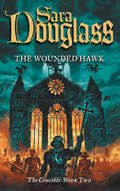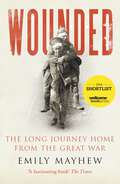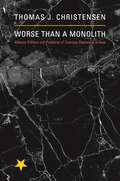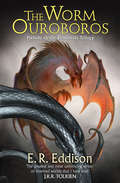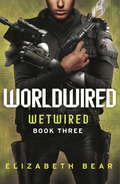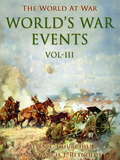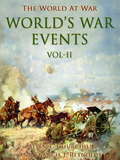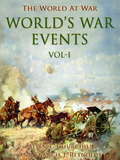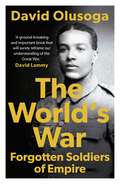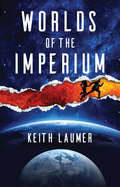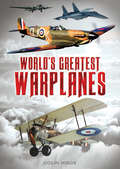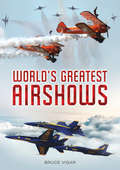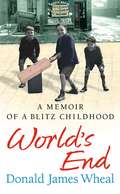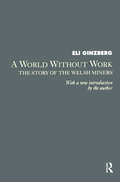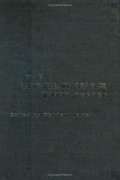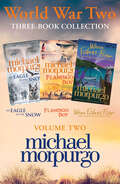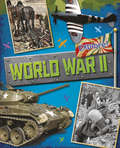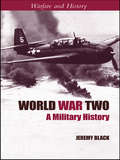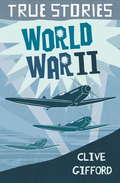- Table View
- List View
Wounds of War: How the VA Delivers Health, Healing, and Hope to the Nation's Veterans (The Culture and Politics of Health Care Work)
by Suzanne GordonU.S. military conflicts abroad have left nine million Americans dependent on the Veterans Health Administration (VHA) for medical care. Their "wounds of war" are treated by the largest hospital system in the country—one that has come under fire from critics in the White House, on Capitol Hill, and in the nation's media.In Wounds of War, Suzanne Gordon draws on five years of observational research to describe how the VHA does a better job than private sector institutions offering primary and geriatric care, mental health and home care services, and support for patients nearing the end of life. In the unusual culture of solidarity between patients and providers that the VHA has fostered, Gordon finds a working model for higher-quality health care and a much-needed alternative to the practice of for-profit medicine.
The wounds of nations: Horror cinema, historical trauma and national identity (PDF)
by Linnie BlakeThe wounds of nations: Horror cinema, historical trauma and national identity explores the ways in which the unashamedly disturbing conventions of international horror cinema allow audiences to engage with the traumatic legacy of the recent past in a manner that has serious implications for the ways in which we conceive of ourselves both as gendered individuals and as members of a particular nation-state. Exploring a wide range of stylistically distinctive and generically diverse film texts, its analysis ranges from the body horror of the American 1970s to the avant-garde proclivities of German Reunification horror, from the vengeful supernaturalism of recent Japanese chillers and their American remakes to the post-Thatcherite masculinity horror of the UK and the resurgence of 'hillbilly' horror in the period following September 11th 2001. In each case, it is argued, horror cinema forces us to look again at the wounds inflicted on individuals, families, communities and nations by traumatic events such as genocide and war, terrorist outrage and seismic political change, wounds that are all too often concealed beneath ideologically expedient discourses of national cohesion. By proffering a radical critique of the nation-state and the ideologies of identity it promulgates, horror cinema is seen to offer us a disturbing, yet perversely life affirming, means of working through the traumatic legacy of recent times.
The wounds of nations: Horror cinema, historical trauma and national identity
by Linnie BlakeThe wounds of nations: Horror cinema, historical trauma and national identity explores the ways in which the unashamedly disturbing conventions of international horror cinema allow audiences to engage with the traumatic legacy of the recent past in a manner that has serious implications for the ways in which we conceive of ourselves both as gendered individuals and as members of a particular nation-state. Exploring a wide range of stylistically distinctive and generically diverse film texts, its analysis ranges from the body horror of the American 1970s to the avant-garde proclivities of German Reunification horror, from the vengeful supernaturalism of recent Japanese chillers and their American remakes to the post-Thatcherite masculinity horror of the UK and the resurgence of 'hillbilly' horror in the period following September 11th 2001. In each case, it is argued, horror cinema forces us to look again at the wounds inflicted on individuals, families, communities and nations by traumatic events such as genocide and war, terrorist outrage and seismic political change, wounds that are all too often concealed beneath ideologically expedient discourses of national cohesion. By proffering a radical critique of the nation-state and the ideologies of identity it promulgates, horror cinema is seen to offer us a disturbing, yet perversely life affirming, means of working through the traumatic legacy of recent times.
The Wounded Hawk: Book Two Of The Crucible Trilogy (The Crucible Trilogy #2)
by Sara DouglassThe second book of The Crucible, an exciting historical fantasy from the author of the popular Axis Triology.
Wounded: From Battlefield to Blighty, 1914-1918
by Emily MayhewThis is the unforgettable story of the remarkable medical workers of World War One.A hundred years ago, the Armistice that ended the Great War was signed. The human cost was devastating: over 21 million military wounded, and nearly 10 million killed. The injuries on the battlefield were unlike anything those in the medical field had ever witnessed. Yet, they adapted incredibly fast – saving millions of lives. Drawing on letters and diary entries, we follow the lone stretcher bearer into the trenches only to find that they were all dead, to the dugouts where rescue teams dug frantically to escape the earth-shaking shellfire, and from stretcher to aid station, from jolting ambulance to crowded operating tent, exploring actual cases of casualties who recorded their terrifying and remarkable experiences. A groundbreaking book of the history of the Western Front from a new perspective, this is a tribute to the indispensable medical network that came together and saved our soldiers.‘A highly readable account...this is an engaging book...they are voices that deserve to be heard.’ Daily Express
Worse Than a Monolith: Alliance Politics and Problems of Coercive Diplomacy in Asia
by Thomas J. ChristensenIn brute-force struggles for survival, such as the two World Wars, disorganization and divisions within an enemy alliance are to one's own advantage. However, most international security politics involve coercive diplomacy and negotiations short of all-out war. Worse Than a Monolith demonstrates that when states are engaged in coercive diplomacy--combining threats and assurances to influence the behavior of real or potential adversaries--divisions, rivalries, and lack of coordination within the opposing camp often make it more difficult to prevent the onset of conflict, to prevent existing conflicts from escalating, and to negotiate the end to those conflicts promptly. Focusing on relations between the Communist and anti-Communist alliances in Asia during the Cold War, Thomas Christensen explores how internal divisions and lack of cohesion in the two alliances complicated and undercut coercive diplomacy by sending confusing signals about strength, resolve, and intent. In the case of the Communist camp, internal mistrust and rivalries catalyzed the movement's aggressiveness in ways that we would not have expected from a more cohesive movement under Moscow's clear control. Reviewing newly available archival material, Christensen examines the instability in relations across the Asian Cold War divide, and sheds new light on the Korean and Vietnam wars. While recognizing clear differences between the Cold War and post-Cold War environments, he investigates how efforts to adjust burden-sharing roles among the United States and its Asian security partners have complicated U.S.-China security relations since the collapse of the Soviet Union.
Worse Than a Monolith: Alliance Politics and Problems of Coercive Diplomacy in Asia
by Thomas J. ChristensenIn brute-force struggles for survival, such as the two World Wars, disorganization and divisions within an enemy alliance are to one's own advantage. However, most international security politics involve coercive diplomacy and negotiations short of all-out war. Worse Than a Monolith demonstrates that when states are engaged in coercive diplomacy--combining threats and assurances to influence the behavior of real or potential adversaries--divisions, rivalries, and lack of coordination within the opposing camp often make it more difficult to prevent the onset of conflict, to prevent existing conflicts from escalating, and to negotiate the end to those conflicts promptly. Focusing on relations between the Communist and anti-Communist alliances in Asia during the Cold War, Thomas Christensen explores how internal divisions and lack of cohesion in the two alliances complicated and undercut coercive diplomacy by sending confusing signals about strength, resolve, and intent. In the case of the Communist camp, internal mistrust and rivalries catalyzed the movement's aggressiveness in ways that we would not have expected from a more cohesive movement under Moscow's clear control. Reviewing newly available archival material, Christensen examines the instability in relations across the Asian Cold War divide, and sheds new light on the Korean and Vietnam wars. While recognizing clear differences between the Cold War and post-Cold War environments, he investigates how efforts to adjust burden-sharing roles among the United States and its Asian security partners have complicated U.S.-China security relations since the collapse of the Soviet Union.
The Worm Ouroboros: The Prelude To Zimiamvia (Barnes And Noble Library Of Essential Reading Ser.)
by E. R. EddisonThe lost classic masterpiece of magical realms, admired by Tolkien and the great prototype for The Lord of the Rings and modern fantasy fiction.
Worldwired: Book Three (Jenny Casey #3)
by Elizabeth BearGive Canada's Master Warrant Officer Jenny Casey an inch and she'll take a galaxy. That's just the kind of person a world on the brink of destruction needs. The year is 2063, and Earth has been brutalized. An asteroid flung at Toronto by the PanChinese government has killed tens of millions and left the equivalent of a nuclear explosion in its wake. Humanity must find another option . . .Perched above the devastation in the starship Montreal, Jenny is still in the thick of the fray. Plugged into the worldwire, connected to a brilliant AI, her mind can be everywhere and anywhere at once. But it's focused on the mysterious alien beings right outside her ship. Are they there to help - or destroy? With Earth a breeding ground for treason and betrayal as governments struggle to assign blame, Jenny holds the fate of humankind in her artificially reconstructed hand . . .
World's War Events, Vol. III (The World At War)
by Francis ReynoldsA three volume series of books describing events of the WW I. This is part three.
World's War Events, Vol. II (The World At War)
by Francis ReynoldsA three volume series of books describing events of the WW I. This is part two.
World's War Events, Vol. I (The World At War)
by Francis ReynoldsA three volume series of books describing events of the WW I. This is part one.
The World's War: Forgotten Soldiers of Empire
by David Olusoga'A groundbreaking and important book that will surely reframe our understanding of the Great War' David Lammy'A genuinely groundbreaking piece of research' BBC History'Meticulously researched and beautifully written' Military History MonthlyIn a sweeping narrative, David Olusoga describes how Europe's Great War became the World's War – a multi-racial, multi-national struggle, fought in Africa and Asia as well as in Europe, which pulled in men and resources from across the globe.Throughout, he exposes the complex, shocking paraphernalia of the era's racial obsessions, which dictated which men would serve, how they would serve, and to what degree they would suffer. As vivid and moving as it is revelatory and authoritative, The World's War explores the experiences and sacrifices of four million non-European, non-white people whose stories have remained too long in the shadows.
Worlds of the Imperium
by Keith LaumerAmerican diplomat Brion Bayard is on assignment in Stockholm when he notices he's being shadowed. Before he can escape, Bayard is kidnapped and transported to a parallel universe: the Imperium, where history has taken a different turn and the British Empire and its allies rule the world. Yet another parallel world exists, and the Imperium has a task there for their reluctant visitor: the impersonation and assassination of a global dictator who happens to be Bayard's otherworldly double.This adventurous, action-packed novel is the work of award-winning author Keith Laumer, creator of the Bolo and Reteif stories. Science-fiction enthusiasts, especially those who enjoy alternate histories, will savor the twists and turns of this imaginative thriller.
World's Greatest Warplanes
by Colin HiggsThe World’s Greatest Warplanes are the ones that get the job done. Visionary engineers and inventors have created some of the most impressive fighting machines. RJ Mitchell’s Spitfire and Sydney Camm’s Hurricane fought for control of the skies against Kurt Tank’s FW190 and Willy Messerschmitt’s Bf 109. Roy Chadwick’s Lancaster and Boeing’s mighty B-17 Flying Fortress battled to take the attack to the enemy in dangerous skies. In the Cold War great names such as the RAF’s Lightning and Vulcan, the US Air Force’s Sabre and Phantom were up against the best from Mikoyan and Gurevich’s Mig factory. And in the last decades the skies have been dominated by the powerhouse American aviation industry. The F-16 is the defender of choice for the West and the amazing B-52 Stratofortress and B2 Spirit stealth bomber provide awesome offensive capability.In this ebook you will discover all these great military aircraft and many more, aircraft that have dominated the skies for more than a century.
World's Greatest Airshows
by Bruce VigarAir shows are one of the world’s most popular, non - sporting outdoor attractions. Although the story of flight is over 100 years old, aircraft still hold a fascination for young and old, men and women from all backgrounds. Indeed, the first air show was held when aircraft and aviation was still in its infancy in the 1900s. Since then aviation has progressed in the full glare of the public gaze.Some air shows are held as a business venture or as a trade event where aircraft, avionics and other services are promoted to potential customers. Many air shows are held in support of local, national or military charities. Military air services often organise air shows at military airfields as a public relations exercise to thank the local community, promote military careers and raise the profile of the military. In this book, we cover the different types of air show and more importantly, the displays that make air shows memorable. For some it is the noise and speed of the latest military jets, for others, extraordinary aerobatics that seem to defy the laws of physics. There are also the displays of classic aircraft and warbirds as well as dramatic reconstructions of how aircraft are deployed. What is clear is how far aviation has come but questions persist in how much farther it can go?
World's End: A Memoir Of A Blitz Childhood
by Donald JamesWorld's End is the story of Donald Wheal¹s childhood in Chelsea's World's End at the height of the Second World War.Not for him the privileged bohemian world of Chelsea a few hundred yards away. Descended from rural immigrants, ladies of the night and bare-knuckle fighters, Donald Wheal¹s upbringing took place amidst grimy factories and generating plants, illegal street bookmakers, dog tracks, tenements and street walkers who plied their trade in Piccadilly and Soho. World's End is the story of how he and his family struggled free from this underclass. It is also an individual history of the Second World War, of a small boy¹s grappling with the bitter separation of evacuation, the return to an already battered London, the wonderland of bomb-damaged houses to play in, and the nights of terror as the Blitz returned.
A World Without Work: Story of the Welsh Miners
by Eli GinzbergWritten just before the beginning of World War II, this is an early example of field research into human resources by one of the pioneers in the area. Ginzberg investigates why so many long-term unemployed coal miners in South Wales remained in their villages rather than relocating to other areas of the United Kingdom where jobs were more plentiful. The results of his work, originally published in 1942, remain of value both as a record of an era, an example of communities in distress, and a model of failed social policy.
A World Without Work: Story of the Welsh Miners
by Eli GinzbergWritten just before the beginning of World War II, this is an early example of field research into human resources by one of the pioneers in the area. Ginzberg investigates why so many long-term unemployed coal miners in South Wales remained in their villages rather than relocating to other areas of the United Kingdom where jobs were more plentiful. The results of his work, originally published in 1942, remain of value both as a record of an era, an example of communities in distress, and a model of failed social policy.
The World War Two Reader (Routledge Readers In History Ser.)
by Gordon MartelFrom highly respected field academic Gordon Martel, The World War Two Reader is a rare work that provides a complete and up-to-date overview of the recent historiography on World War Two. Huge in scope, both geographically and thematically, this excellent reader examines twenty-one articles by some of the best known and most innovative scholars in the field. Taking a global approach, Martel discusses all aspects of the war including: the military aspect the political and strategic backdrop ideology gender and women’s roles the home front social aspects. Including a comprehensive introduction, chronology, guides to key terms and figures, and introductions to chapters providing context and historiographical background, The World War Two Reader provides wide ranging and innovative reading for all students of the history of the modern world.
World War Two Collection: An Eagle In The Snow, Flamingo Boy, When Fishes Flew
by Michael MorpurgoAn ebook collection of three of master storyteller Michael Morpurgo’s Second World War novels.
World War Two: World War Two (Explore! #9)
by Jane BinghamThis photographic book gives you an overview of World War Two. From how the war began to how it spread worldwide, the new technology that was used in war for the first time, how women's roles changed in society because of the war, what life was like on the home front, and how the war was recorded in pictures, diaries, poems and stories. You can learn about key figures, such as Winston Churchill, and events, such as The Holocaust. You can also read a diary entry from the Blitz and learn how to create your own secret code.
World War Two: A Military History (Warfare and History)
by Jeremy BlackCutting through over half a century of historical build-up, this new and convincing account of World War II uses a global perspective to explain the complicated course in military terms. Black, a distinguished military historian , bucks the current trend to demilitarise and gives due weight to the campaigns and battles that made up the war. In doing so he challenges common interpretations and includes new insights to make this one of the most exciting new histories of the Second World War. Covering all the main areas of conflict, the chronological approach includes analysis of attacks at land, air and sea and a comparison of military resources. The focus is always operational, but social, cultural and political aspects are also included. Providing a crucial counterweight to previous histories, Jeremy Black's World War Two offers fresh insights into operations at the Eastern Front and during the war against Japan.
World War Two: A Military History (Warfare and History)
by Jeremy BlackCutting through over half a century of historical build-up, this new and convincing account of World War II uses a global perspective to explain the complicated course in military terms. Black, a distinguished military historian , bucks the current trend to demilitarise and gives due weight to the campaigns and battles that made up the war. In doing so he challenges common interpretations and includes new insights to make this one of the most exciting new histories of the Second World War. Covering all the main areas of conflict, the chronological approach includes analysis of attacks at land, air and sea and a comparison of military resources. The focus is always operational, but social, cultural and political aspects are also included. Providing a crucial counterweight to previous histories, Jeremy Black's World War Two offers fresh insights into operations at the Eastern Front and during the war against Japan.
World War Two (True Stories)
by Clive GiffordThe book contains nine short stories dealing with different aspects of life during World War II.Included is the remarkable survival story of future US President J F Kennedy, the story of the dambusters and a plotted assassination attempt on Hitler.Complete with glossary, further reading section and index.
